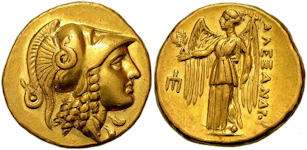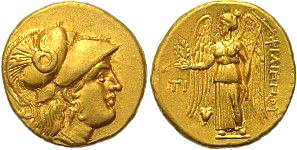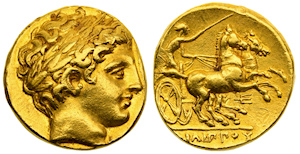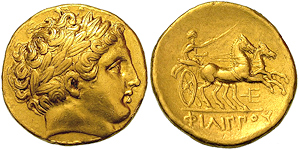Fine Coins Showcase
Antiquities Showcase
Show Empty Categories
Shop Search
Shopping Cart
My FORVM
Contact Us
About Forum
Shopping at Forum
Our Guarantee
Payment Options
Shipping Options & Fees
Privacy & Security
Forum Staff
Selling Your Coins
Identifying Your Coin
FAQs
zoom.asp
Home ▸ Catalog ▸ |Greek Coins| ▸ |Geographic - All Periods| ▸ |Macedonia||View Options:   | | | | | | |


Troxell did not find links to these dies in the series, but footnote 6, on p. 107, indicates this coin is from series 2. The dies, which match Troxell pl. 24, H, are very similar to Troxell, series 2, pl. 21, 501 (= SNG Sweden II 993) and they were likely engraved by the same hand.SH87557. Gold stater, Troxell pl. 25, H (same dies); SNG Sweden II 993; Price 172; Müller 105; SNG Ashmolean 2522; SNG Cop -; SNG Alpha Bank -; SNG Munchen -, Choice EF, mint luster, some light bumps and marks, weight 8.592 g, maximum diameter 18.7 mm, die axis 135o, Macedonia, Amphipolis mint, struck under Antipater, c. 327 - 325 B.C.; obverse head of Athena right wearing earring, necklace, and crested Corinthian helmet decorated with a coiled snake; reverse Nike standing left, wreath in right hand, stylus in left hand, trident-head downward (control symbol) in left field, AΛEΞANΔPOY downward on right; SOLD
Macedonian Kingdom, Philip II, 359 - 336 B.C.


Struck shortly after Alexander the Great's death during the joint reign of Philip III, Alexander's mentally disabled brother, and the infant king Alexander IV, Alexander's infant son with the Bactrian princess Roxana. The two were made joint kings by Alexander's generals who, knowing they could not rule, only intended to use them as pawns. Philip III was imprisoned upon his return to Macedonia, and in 317 B.C. he was executed under orders from Olympias. Alexander IV and his mother Roxana were executed by the boy's regent, Kassander, in 311 B.C. We don't know if this coin was posthumously struck in the name of Philip II, or struck in the name of the reigning (but not ruling) Philip III.SH68354. Gold stater, Le Rider p. 146 & pl. 58. 157 (D42/R112), SNG ANS 172 ff., SNG Cop 529, SNG Alpha Bank -, EF, perfect centering, weight 8.602 g, maximum diameter 18.0 mm, die axis 0o, Pella mint, posthumous, 323 - 317 B.C.; obverse laureate head of Apollo right; reverse ΦIΛIΠΠOY (in exergue), charioteer driving biga right, kentron in right, reins in left, kantharos below; ex Gorny & Mosch auction 215, lot 758; SOLD
Macedonian Kingdom, Philip II of Macedonia, 359 - 336 B.C.


Philip II expanded the size and influence of the Macedonian Kingdom but is perhaps best known as the father of Alexander the Great. He personally selected the design of his coins.SH82680. Gold stater, Le Rider 229 (D67/R174), SNG ANS 144 (same dies), SNG Cop 524, HGC 3 847, Choice aEF, beautiful classical style, well centered, slight double strike, light marks, weight 8.575 g, maximum diameter 17.6 mm, die axis 90o, Macedonia, Amphipolis mint, c. 340 - 328 B.C.; obverse laureate head of Apollo right; reverse charioteer in fast biga right, trident head right below horses forelegs, ΦIΛIΠΠOY exergue; SOLD
Macedonian Kingdom, Alexander the Great, 336 - 323 B.C.


Struck during the lifetime of Alexander the Great.SH77066. Gold stater, Price 172, Müller Alexander 105, Choice aEF, mint luster, superb style, high relief, good strike, weight 8.580 g, maximum diameter 18.4 mm, die axis 270o, Macedonia, Amphipolis mint, c. 327 - 325 B.C.; obverse head of Athena right wearing earring, necklace, and crested Corinthian helmet decorated with a coiled snake; reverse AΛEΞANΔPOY, Nike standing left, wreath in right hand, stylus in left hand, trident-head downward (control symbol) in left field; SOLD
Macedonian Kingdom, Philip II of Macedonia, 359 - 336 B.C.


Philip II expanded the size and influence of the Macedonian Kingdom but is perhaps best known as the father of Alexander the Great. He personally selected the design of his coins.SH57285. Gold stater, Le Rider 339 (D62/R259), SNG ANS 144 ff., Choice aEF, weight 8.554 g, maximum diameter 18.4 mm, die axis 180o, Amphipolis mint, c. 340 - 328 B.C.; obverse laureate head of Apollo right; reverse charioteer in biga right, trident head below horses, ΦIΛIΠΠOY exergue; ex Harlan Berk, attractive style, perfect centering; SOLD
Macedonian Kingdom, Philip III Arrhidaeus and Alexander IV, 323 - 317 B.C.


Philip III Arrhidaeus, the bastard son of Philip II and a dancer, Philinna of Larissa, was Alexander the Great's half-brother. Alexander's mother, Olympias, allegedly poisoned him as a child, leaving him mentally disabled, eliminating him as a rival to Alexander. Incapable of actual rule, he was made king upon Alexander's death only to serve as a pawn for those who wished to grab power for themselves. Olympias had him imprisoned and then ordered his execution in 317 B.C.SH72613. Gold stater, Price P90, ADM I 228 - 230, Müller Alexander -, SNG Cop -, EF, lovely Hellenistic style, mint luster, weight 8.579 g, maximum diameter 18.4 mm, die axis 0o, Sardes (Sart, Turkey) mint, c. 323 - 317 B.C.; obverse head of Athena right in crested Corinthian helmet ornamented with a coiled snake, wearing necklace and long drop earring; reverse ΦΙΛΙΠΠΟΥ, Nike standing left, wreath in extended right hand, grounded stylis in left at her side, TI left, rose left under wing; ex Roma Numismatics auction 8, lot 470; SOLD
Macedonian Kingdom, Alexander the Great, 336 - 323 B.C.


Born a leader, his genius and charisma led the Macedonian army to create an empire covering most of the then-known world, from Greece to India. His reign begins the Hellenistic Age, a time when civilization flourished. He was regarded as a god and his fame grew even greater after his premature death at thirty-two.SL95868. Gold stater, Price 168a (same dies), Müller Alexander 193, Newell Tarsos 12, HGC 3.1 893a (S), ICG AU80 (1507680109, Tarsos, Pr#3004), Macedonia, Amphipolis mint, struck under Antipater, c. 328/5 - 323/319 B.C.; obverse head of Athena right wearing earring, necklace, and crested Corinthian helmet decorated with a coiled snake; reverse Nike standing slightly left, head left, wreath in extended right hand, stylus in left hand, kantharos left; ICG| Lookup; scarce; SOLD
Macedonian Kingdom, Philip II of Macedonia, 359 - 336 B.C.


Philip II expanded the size and influence of the Macedonian Kingdom but is perhaps best known as the father of Alexander the Great. He personally selected the design of his coins.SH96387. Gold stater, Le Rider pl. 62, 282A (D87/R216A); SNG ANS 144; SNG Cop 524; HGC 3 847, aEF, luster, attractive style, edge shaved in antiquity, weight 7.518 g, maximum diameter 17.2 mm, die axis 0o, Macedonia, Pella mint, c. 340 - 328 B.C.; obverse laureate head of Apollo right; reverse charioteer in fast biga right, kentron in right hand, reins in left hand, trident head right below horses forelegs, ΦIΛIΠΠOY exergue; ex Roma Numismatics e-sale 70 (7 May 2020), lot 509; Morton & Eden Ltd. ; SOLD
Macedonian Kingdom, Philip II of Macedonia, 359 - 336 B.C.


Philip II expanded the size and influence of the Macedonian Kingdom but is perhaps best known as the father of Alexander the Great. He personally selected the design of his coins.SH70337. Gold stater, Le Rider 341 (D152/R260), SNG ANS 154, Choice gVF, attractive style, perfect centering, light marks, weight 8.513 g, maximum diameter 19.1 mm, die axis 270o, Amphipolis mint, c. 340 - 328 B.C.; obverse laureate head of Apollo right; reverse charioteer in biga right, trident head below horses, ΦIΛIΠΠOY exergue; SOLD
Macedonian Kingdom, Alexander the Great, 336 - 323 B.C.


Struck at Amphipolis under Antipator. When Alexander the Great set out on his Asiatic expedition in 334 B.C., Antipater was left behind as regent in Macedonia and strategos of Europe. After Alexander died, the regent, Perdiccas, left Antipater in control of Greece.SL87034. Gold stater, Price 164, Müller Alexander 2, SNG Cop 625, NGC AU, strike 5/5, surface 4/5, light graffiti (2818437-001); attractive style, weight 8.60 g, maximum diameter 17.3 mm, die axis 270o, Amphipolis mint, possibly a lifetime issue, c. 325 - 319 B.C; obverse head of Athena right wearing earring, necklace, and triple-crested Corinthian helmet decorated with a coiled snake, light graffito X below chin; reverse AΛEΞANΔPOY, Nike standing left, wreath in right hand, stylis in left, fulmen (thunderbolt) in left field; NGC| Lookup; SOLD

You are viewing a SOLD items page.
Click here to return to the page with AVAILABLE items.
The sale price for a sold item is the private information of the buyer and will not be provided.
REFERENCES|
Page created in 1.938 seconds.






